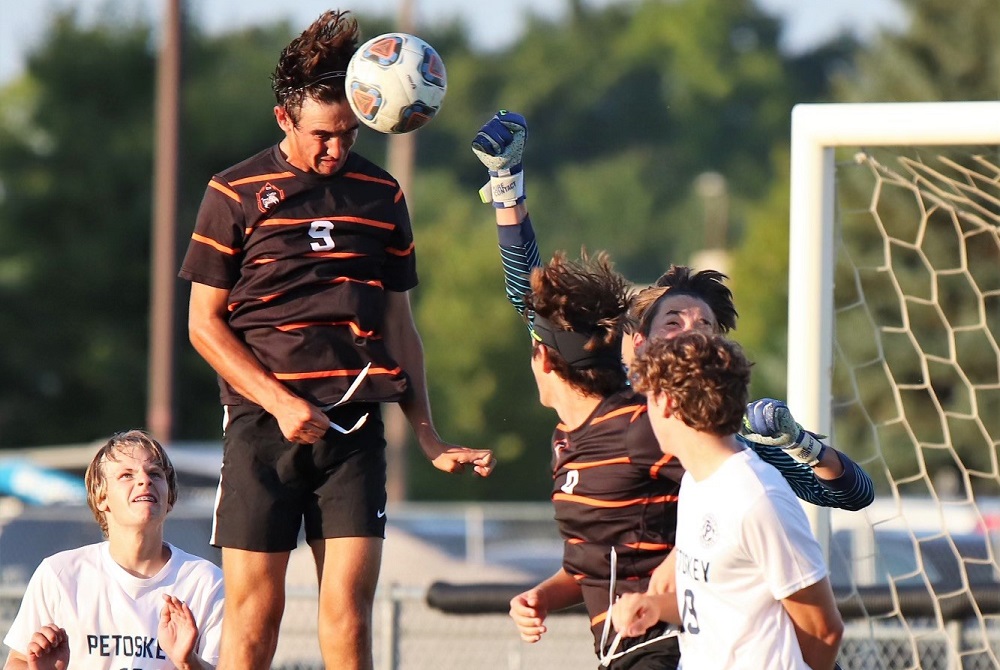
Several Northern Michigan Hopefuls Setting Up for Potential Postseason Success
By
Tom Spencer
Special for MHSAA.com
September 9, 2022
Not a whole lot is changing — yet — in the Big North, Northwest and Lake Michigan soccer conferences this year.
 Traverse City Christian, an independent, is taking on schools from all three and wants a different District result to get back to Regionals this fall. And, perhaps surprisingly, Kalkaska is looking to change things too.
Traverse City Christian, an independent, is taking on schools from all three and wants a different District result to get back to Regionals this fall. And, perhaps surprisingly, Kalkaska is looking to change things too.
Traverse City West, Elk Rapids and Christian loaded up their early season with strong nonconference competition. Nothing new. And Leland and Buckley, fast becoming arguably the biggest rivals in northern Michigan, did the best they could to schedule nonconference competition aimed at leading to yet another deep postseason run.
Of course West and Elk Rapids have their eyes on the postseason — again — as well.
West, coming off its annual Labor Day weekend tournament hosting Grand Haven, Midland Dow and Mason, is off to a 6-1 start, posting shutouts in its first four contests. Christian is 5-1-1.
Elk Rapids is off to a 2-5-1 start. That’s not a misprint.
And, by the way, Kalkaska is undefeated in regulation in its first six games.
That’s not an error either. Third-year coach David Wagner has his Blazers playing well and has seen some stellar goaltending by junior Kayden Dueweke-Gonzales. A shootout loss is the only blemish.
Wagner is hoping his team can pick up more wins than has been the case for some time for the Blazers in the Lake Michigan Conference.
“I think we will be much more competitive than we were last year,” Wagner said of the Blazers, who are 5-1 overall and 2-0 in Lake Michigan play.
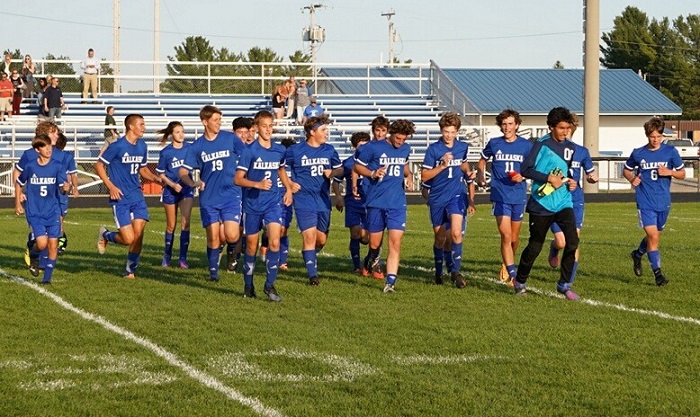 Nate Plum, now is his 15th year at the helm of Elk Rapids, is not overly concerned about his team’s win-loss record at this moment. He’s more concerned with the Elks learning from their experiences and hopes he will see stronger competition in the Lake Michigan Conference this year from teams like Kalkaska.
Nate Plum, now is his 15th year at the helm of Elk Rapids, is not overly concerned about his team’s win-loss record at this moment. He’s more concerned with the Elks learning from their experiences and hopes he will see stronger competition in the Lake Michigan Conference this year from teams like Kalkaska.
Despite what many would call a slow start, the Elks are still rated among the state’s top Division 3 soccer teams and are drawing the attention of the soccer community across the state.
Elk Rapids has made many postseason runs under Plum, who came into this fall with a 241-102-33 record as the Elks coach. Elk Rapids reached the Division 3 Semifinals last season before losing a shootout to the eventual champion, Grand Rapids South Christian. The Elks also reached the Semifinals in 2020, falling to South Christian. Elk Rapids has won four straight District titles, the last two in part because of one-goal and shootout wins over TC Christian.
The Elks prioritize playing teams like they may see at the end of the season, allowing the competition and conditions to force improvements. Teams are getting stronger in the Lake Michigan Conference, Plum is excited to note, but Elk Rapids hasn’t lost a league game in five years.
So the Elks have looked for opportunities to play on turf and tough environments like TC West and East Grand Rapids.
“The boys would rather be playing in late October than racking up wins now,” Plum said. “I know I’ve got to put them in situations where they have to get better — the only way the boys can get better sometimes is play games we’re not going to have the ball the entire time and they’re going to challenge us and put us in uncomfortable spots.
“When the games really matter at the end of the year and we find ourself in tough situations, we can say, ‘We’ve been in something like this, and we’ve seen it before,’” he continued. “Maybe putting us in those situations are more important to me than wins.”
TC Christian, a long-time regular and postseason opponent of the Elks, has its eyes set on knocking off the Elks in the District this time.
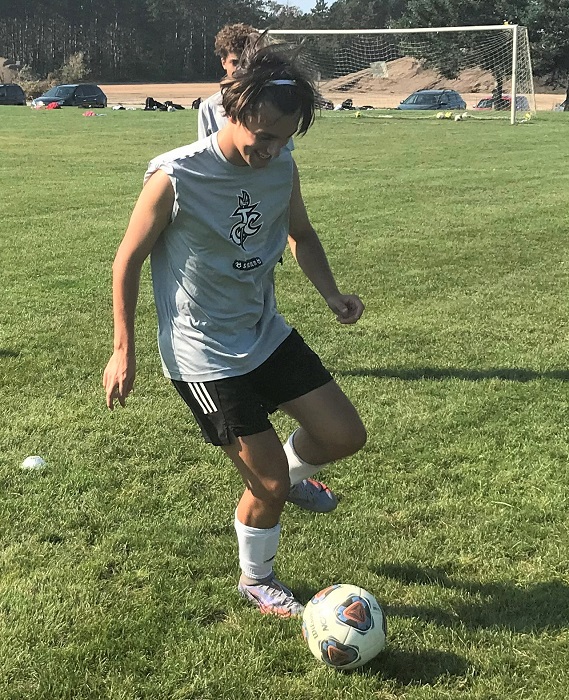 The Sabres are getting closer, but they haven’t made a Regional appearance since 2010. They will host the Elks on Sept. 20.
The Sabres are getting closer, but they haven’t made a Regional appearance since 2010. They will host the Elks on Sept. 20.
Roy Jay Montney, who owns a 37-10-3 record with the Sabres, said since they are independent, his program schedules every game with the postseason in mind.
“We are not in a league, so we are thinking of the postseason,” Montney said. “We’re preparing for the postseason each game.”
The coaches share mutual respect.
“Elk Rapids is great program,” Montney said. “They’ve put together a consistent team and program for years.
“They will be strong and they will come out to play, and hopefully we’ll be ready for it.”
Christian is not ready to focus on the Elks yet. They will play Holland, Midland and Traverse City Central before that Sept. 20 meeting on the pitch.
“They’re (Sabres) tough competition, no question about that,” said Plum. “A lot of times I feel the one during the season is a soccer game and the next one is a bunch of emotion.
“Nobody wants to lose come October, and everyone is playing like it’s their last game,” Plum continued. “They have to make it really tough to win the District and you’ve got to give them credit for that.”
The Elks have been led by junior Alex Smith, who has four goals and two assists so far. The Sabres have been led by senior Henry Reineck’s six goals and one assist.
Buckley, coming off its first Northwest Conference championship won last fall, is hoping to repeat but again must get past perennial league champ Leland (2-2-1), which has made many deep postseason runs including to the Division 4 championship in 2018.
Leland reached the Regionals in 2019 and 2020 before suffering a 1-0 District championship loss to Buckley in 2021. Rob Sirrine, now in his second year as the head coach, was an assistant coach for the Comets during those runs.
“We’ve got a really young team this year and are excited to see which underclassmen step up and contribute,” said Sirrine. “Our goal is to make it to Regional Finals at a minimum.
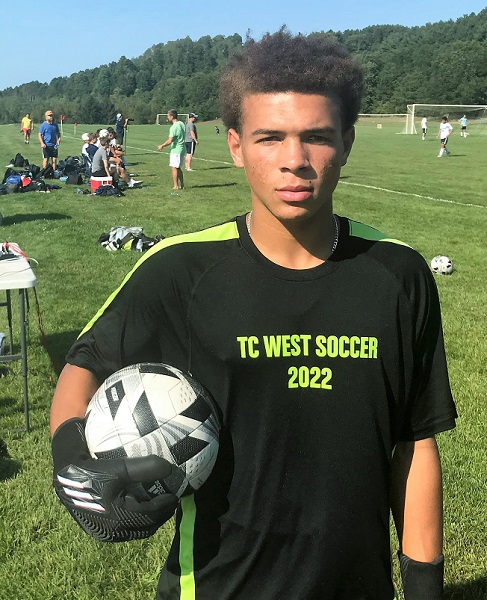 “We’ve had a few solid games and a few lackluster games so far, but it’s early,” he continued. “We’ll be working out the kinks over the next several weeks to be ready for playoffs this year.”
“We’ve had a few solid games and a few lackluster games so far, but it’s early,” he continued. “We’ll be working out the kinks over the next several weeks to be ready for playoffs this year.”
The playoffs will come after home and away games with Buckley in league play. The Bears and Comets are competing in different Division 4 Districts this year. Instead of loading up the nonleague schedule, capturing a league crown is critical to the Bears’ postseason preparation, veteran coach John Vermilya pointed out.
“We haven’t gone to the lengths of like Elk Rapids, TC Christian and Leland,” he said. “They’re always playing the biggest dog they can get.
“We’re trying to get a flavor of what is outside of our conference,” he continued. “We are just trying to win games and get one of the two seeds in District play.”
The Bears are going into a game today with Manistee, a Division 3 team, at 4-3-1. They’ve recently benefited from two Spanish and one Italian exchange student entering the district.
Buckley lost to eventual Division 4 champion Wyoming Potter’s House Christian in a Regional Semifinal last year.
Meanwhile, Traverse City West (6-1) is eying another postseason run and taking on Holland on Saturday. The Titans picked up a win in their conference opener Thursday over Petoskey.
Since taking over the West helm in 2015, Matt Griesinger has guided the Titans to a 123-30-15 record, District championships the last three seasons and Division 1 Finals appearances in 2019 and 2020.
The Titans have won the Big North Conference the last 12 years. Griesinger credits senior goalie Trae Collins for much of the early success this fall. Collins has a goals-against average of 0.81 through seven games.
Petoskey dropped to 6-5 overall with the West loss.
 Tom Spencer is a longtime MHSAA-registered basketball and soccer official, and former softball and baseball official, and he also has coached in the northern Lower Peninsula area. He previously has written for the Saginaw News, Bay County Sports Page and Midland Daily News. He can be reached at [email protected] with story ideas for Manistee, Wexford, Missaukee, Roscommon, Ogemaw, Iosco, Alcona, Oscoda, Crawford, Kalkaska, Grand Traverse, Benzie, Leelanau, Antrim, Otsego, Montmorency, Alpena, Presque Isle, Cheboygan, Charlevoix and Emmet counties.
Tom Spencer is a longtime MHSAA-registered basketball and soccer official, and former softball and baseball official, and he also has coached in the northern Lower Peninsula area. He previously has written for the Saginaw News, Bay County Sports Page and Midland Daily News. He can be reached at [email protected] with story ideas for Manistee, Wexford, Missaukee, Roscommon, Ogemaw, Iosco, Alcona, Oscoda, Crawford, Kalkaska, Grand Traverse, Benzie, Leelanau, Antrim, Otsego, Montmorency, Alpena, Presque Isle, Cheboygan, Charlevoix and Emmet counties.
PHOTOS (Top) Elk Rapids' Caden Moore (9) gets his head on the ball during an Aug. 23 game against Petoskey. (2) Keeper Kayden Dueweke-Gonzales leads Kalkaska in its warm up before Thursday’s win over Boyne City. (3) Henry Reineck kicks the ball around during a Traverse City Christian practice. (4) Traverse City West keeper Trae Collins takes a moment during his school’s junior varsity game. (Top photo by Kate Parrish, Kalkaska photo courtesy of the Blazers’ athletic department, and Traverse City Christian and West photos by Tom Spencer.)
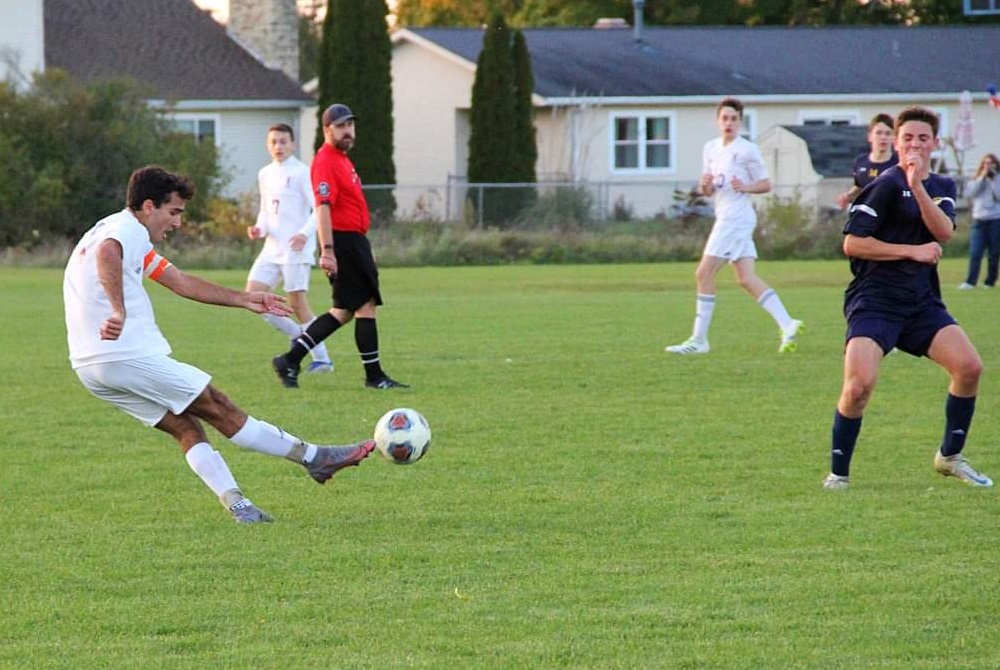
Seniors Lead Midland Calvary Baptist's Rise from MHSAA Debut to District Championship
By
Paul Costanzo
Special for MHSAA.com
October 26, 2022
James Day wasn’t surprised by how quickly his Midland Calvary Baptist boys soccer team was competing for postseason titles.
 But when the Kings won their first District title recently, in just their fourth MHSAA postseason, he did feel they had proved something to those outside the program.
But when the Kings won their first District title recently, in just their fourth MHSAA postseason, he did feel they had proved something to those outside the program.
“I think to a certain level, yes, (we had to prove) that we can actually win the title, that District title,” the Calvary Baptist coach said. “I think, too, it was so exciting because there are several players that have played in virtually all of (the program’s postseason) games.”
Led by its five seniors, Calvary Baptist defeated Saginaw Valley Lutheran 2-1 on Oct. 21 to win that Division 4 District title. It came after the team had advanced to the District Final in each of its previous three tries.
After seeing plenty of success in the Michigan Association of Christian Schools, the Kings made the leap to the MHSAA and participated in their first postseason in 2019. That year, they lost to Roscommon 1-0 in the District Final. They fell to Bad Axe in the District Final each of the next two seasons.
“The first three years, we’d been super close,” senior midfielder Charley Tomko said. “The last two years we lost to Bad Axe in the District championship, and going into this year, my goal was to win a District championship. We didn’t beat Bad Axe in the championship game, but we beat a really solid team to win it. Going into the season, this was my goal – this was our team’s goal – and we figured it out and were able to execute.”
Tomko and classmates John Adams, Isaac Wallace, Dyllon Ouderkirk and Lucian Snyder make up the core of the team. Most of them have been playing soccer together since middle school, and have known each other since kindergarten.
“It really helps,” said Adams, a senior center back. “I’ve known our keeper (Snyder) since we were 7 years old. It helps because we’ve played with each other for a lot of years. We’re friends on and off the field, and obviously it really helps when we’re on the field because we communicate and work together.”
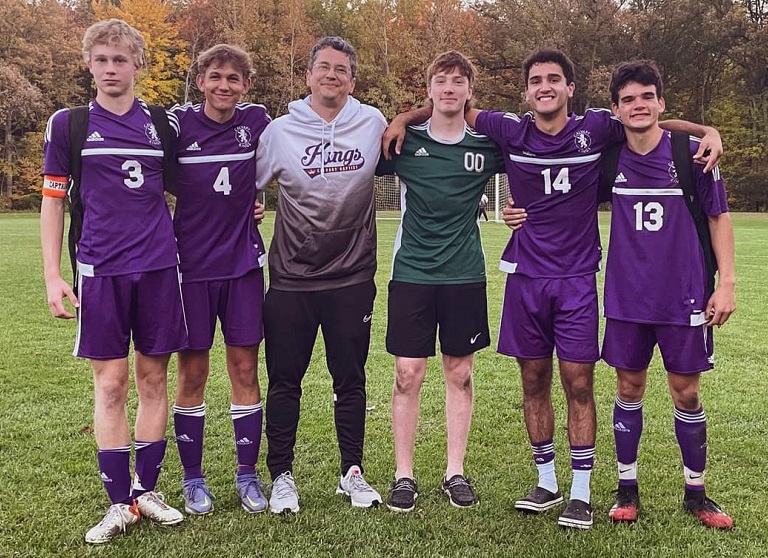 The five seniors are also spread throughout the four levels of the Kings’ formation, which helps create a balance that Day said is the strength of his team.
The five seniors are also spread throughout the four levels of the Kings’ formation, which helps create a balance that Day said is the strength of his team.
Snyder plays in goal, with Adams at center back and Wallace at right back on defense. Tomko is an attacking midfielder, and Ouderkirk plays forward, where he’s netted more than 20 goals this season.
“It really does help to have an experienced player throughout all parts of the field,” Adams said. “We all understand how all of us play.”
The bond between those seniors – and the entire team – has been formed and strengthened by much more than their play.
During their sophomore season, their friend and teammate Stephen Kipfmiller died after a battle with leukemia. While his memory remains a constant in their minds, the Kings also do their best to continue to honor him outwardly. His number 19 was retired by the program, and their captains armbands are orange, representing leukemia awareness.
“That group has gone through a lot of adversity not just on the field, but off of it,” Day said. “Seeing how, even through struggle and hardship, there’s things we can do on and off the field that bring joy. Winning a title is temporary, but at the end of the day, it was fulfilling, too. There’s this bond we’ve formed around the sport, and it’s been great to be able to honor our friend Stephen and his life.”
Kipfmiller’s brother, Caleb, is a coach in the program, and his parents are regulars at the team’s games.
“When Stephen passed, we were sophomores, and since that year, the brotherhood between the seniors and all of our teams, and even our school, has grown an immense amount,” Tomko said. “His parents are still involved with our teams, they come to every home game. It’s really cool to play for God’s glory, and also to have that memory of Stephen. He always worked as hard as he could. Just the way he led the team, too, it’s something I look up to now. I remember Stephen being one of those silent leaders who was always calm and collected.”
No matter what happens in Wednesday night’s Regional Semifinal against Leland, or possibly after that, this year’s Calvary Baptist team, and specifically its group of seniors, have already cemented its legacy.
“We put in so many hours of work to improve our game and improve our chances in the season,” Tomko said. “When we first entered the MHSAA our freshmen year, we had a really solid group of seniors and juniors. Going into that, we did kind of set a high standard. It’s so cool that four years into being in the MHSAA, we won a District, and hopefully more. Looking back, it’s really cool to see how much this team has accomplished.”
 Paul Costanzo served as a sportswriter at The Port Huron Times Herald from 2006-15, including three years as lead sportswriter, and prior to that as sports editor at the Hillsdale Daily News from 2005-06. He can be reached at [email protected] with story ideas for Genesee, Lapeer, St. Clair, Sanilac, Huron, Tuscola, Saginaw, Bay, Arenac, Midland and Gladwin counties.
Paul Costanzo served as a sportswriter at The Port Huron Times Herald from 2006-15, including three years as lead sportswriter, and prior to that as sports editor at the Hillsdale Daily News from 2005-06. He can be reached at [email protected] with story ideas for Genesee, Lapeer, St. Clair, Sanilac, Huron, Tuscola, Saginaw, Bay, Arenac, Midland and Gladwin counties.
PHOTOS (Top) Midland Calvary Baptist’s Charley Tomko, far left, sends a shot during a game this season. (Middle) The Calvary Baptist seniors (and coach), from left: John Adams, Isaac Wallace, coach James Day, Lucian Snyder, Charley Tomko and Dyllon Ouderkirk. (Photos courtesy of the Calvary Baptist boys soccer program.

